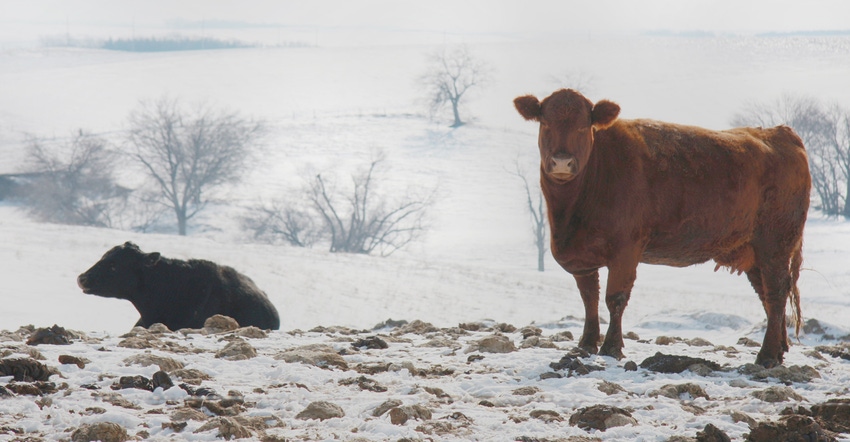Research has shown that body condition is directly related to reproductive performance and thus profitability in cow calf operations. Now that the calves are weaned, winter is the perfect time to focus on putting weight back on those cows for little investment.
December 1, 2018

Sponsored Content
There are three main reasons that the time immediately after weaning is a great time to add condition to your cows, for very little investment.
Those cows are no longer lactating. It is difficult to increase a cow’s body fat stores during lactation and it is not uncommon for a productive cow to drop in body condition during lactation. Lactation takes a large portion of energy each day for a cow. The priorities for partitioning energy from the diet in a beef cow, are first, for maintenance, then lactation, and then gain. By removing the lactation energy requirement, you immediately push all that energy after maintenance into gain.
The cow’s maintenance energy requirement was mentioned in number 1 above. Maintenance energy requirements increase as temperatures increase or decrease from a cow’s thermal neutral zone. The thermal neutral zone is a moving target that is greatly impacted by, for example, hair coat, moisture and wind. Many would agree that cow’s maintenance energy requirements will be lower with the average temperatures we see in October and November, versus January or February. This lower maintenance energy requirement frees up more energy for weight gain.
While the maintenance energy requirements are lower in late fall and early winter versus January due to warmer temperatures, a spring calving cow will also have lower fetal energy requirements during mid-gestation in the fall and early winter than she will need through late gestation and next spring prior to calving. Here again, this means more of her daily energy intake can go to weight gain today, versus 2-3 months from now.
Practical use of body condition scores
Research has shown that body condition is directly related to reproductive performance and thus profitability in cow calf operations. By identifying the body condition of cattle within your herd, you can make informed decisions on a feeding program designed to maximize profitability. Cows will not breed at acceptable rates without adequate body fat. More often than not it is more cost effective to maintain a cow in ideal body condition than it is to allow her to become too thin and then try to put condition back on or to allow her to remain too thin.
What helps cattle maintain body condition?
During winter months, many cattle producers rely primarily on hay as feed. Because hay quality varies so much, anything we can do to increase the efficiency of hay digestion is going to help productivity. While cows will generally gain weight in the fall after weaning, most forages are of poorer quality this time of year. Cows will respond greatly to even a little protein supplementation. Protein supplementation of low quality forages (whether grazed or fed in bales) will increase the digestibility (energy release) and intake (providing even more energy available to the cow). Many cattlemen refer to this as stretching their forage.
Why is protein so important for fiber digestion?
Low quality forages contain high amounts of hard to digest fiber and protein is key to optimal fiber digestion and intake.
Ruminally available protein is a limiting factor in fiber fermentation.
Protein is a key component for microbial adhesion to fiber which is needed to begin the fiber digestion process.
Protein is also needed for microbial fermentation of fiber to form volatile fatty acids (VFAs) and microbial protein, 2 major energy sources for cattle.
Additionally, inadequate dietary protein depresses animal performance, in turn depressing appetite which further hinders animal performance.
For all of the reasons above, protein supplementation improves forage digestion and increases forage intake. Research shows that it doesn’t take much protein to enact a positive influence. Supplementation with limited amounts (less than 2 pounds) of a high protein supplement increased digestibility and intake of lower quality forages in numerous studies.
For more information about how the CRYSTALYX® line of protein self-fed supplements might be a fit for your herd this winter, visit www.crystalyx.com.
About the Author(s)
You May Also Like



